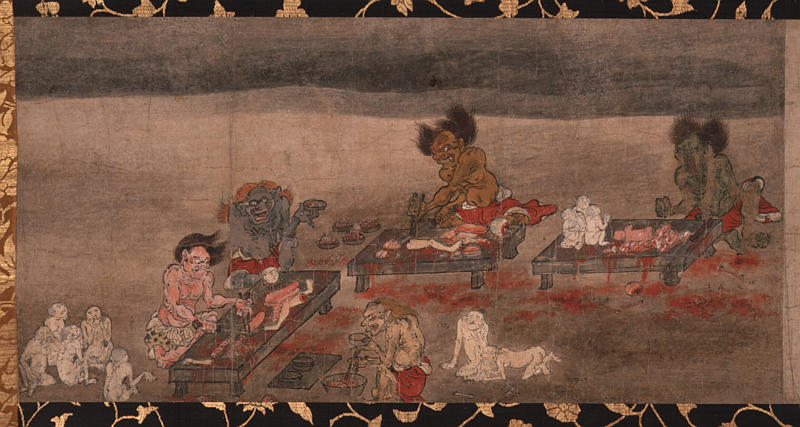The Hell of Dissection
- Kamakura period
- 13c
- Hanging scroll, color and ink on paper
- H-26.1 W-90.5
- Formerly in the collection of Masuda Don'no
Catalogue Entry
Kamakura period, 13th century
Hanging scroll, color and ink on paper
Height, 26.1cm; width, 90.5cm
This now-fragmented handscroll was originally made up of seven scenes depicting the Shamon Jigoku, or "hell for priests" (monks) who have committed sins. The text source for this hell for priests was the Hotatsumonhoo-shamon-kyo promulgated in the Tang dynasty, and this text states that in the iron-fenced mountains to the east, there is a boundless hell with 32 hells for priests. This 16-scroll set of the Fo-ming-ching sutra created in the Tang dynasty contains this sutra, and this Fo-ming-ching sutra became the text for the Butsumyoe, one of the annual events held at year's end in the Imperial Palace during the Heian period to repent sins and offenses. Thus the contents of this sutra were widely known during that period.
The hell of dismemberment is the hell for priests who have killed living beings and dismembered their victims. The sutra text depicts the brutal scene of the offenders who were hung from iron beams, their bodies cut up with saws, and then their flesh eaten and their blood drunk by birds and animals. The text that accompanies this painting states that the legs and arms of the victims are cut off by demons, and then the flesh is torn from their bones, and is further ground into dust. Then these demons would strike their cutting boards, shouting "Live! Live!" and the destroyed flesh would reform as humans, all to be dismembered again like so many catfish. This recurring atrocity only helps to emphasize the endless nature of hell.
Here the top of the composition is coated with ink clouds symbolizing the lightless gloom of hell, and in accordance with the accompanying text, the lower half of the composition shows an arrangement of 3 cutting boards, and following the text's description and working clockwise, the various processes of dismemberment are shown. Taking a hint from the catfish imagery mentioned in the text, this scene is depicted as nothing more than a demon's kitchen and banquet, and the artist's creativity adds the humorous touch of the expression on the demon cannibals' faces as they sample the fare. The figure of the demon on the left who uses knives and chopsticks as he carves the meat can also be seen in the image of the Shamon Jigoku from the 7th scroll of the Jokyu version of the Kitano Tenjin Engi.
Including the present scroll, the works that are generally known as images of the Six Paths were created amidst the spread of the Six Paths doctrine during the Heian period and the resulting narrative interest in the sutra contents. These paintings are all characterized by nimble brush-work used to provide detailed renderings of the tortures of hell, and the objectivity that colors this depiction and the compositional arrangement which emphasizes the narrative nature of the text lessen the dominant sense of fear evoked by these horrors, all aspects which suggest an early Kamakura-period date for this work. JW

